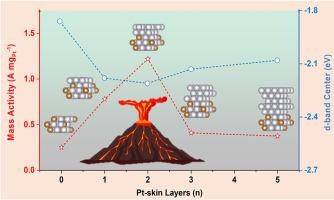Precise Pt-skin manipulation of strain and ligand effects for oxygen reduction
IF 36.6
Q1 ELECTROCHEMISTRY
引用次数: 0
Abstract
Nanostructured platinum (Pt)-skin alloys are promising electrocatalysts for oxygen reduction reaction (ORR) due to their tunable strain and ligand effects which essentially regulate the surface electronic structures. In addition to the chemical nature of alloying elements, the layer numbers of Pt-skin crucially determine the strain and ligand effects. So far, the effects of Pt-skin layer numbers have been generally investigated through vapor deposition on bulk metals and alloys with extended surfaces, while the precise Pt-skin control of nanostructured alloy electrocatalysts in wet chemical synthesis remains fairly challenging. Herein, we develop a Pt-skin engineering strategy to construct a family of dendrite-like porous PtCu@PtnL nanospheres (NSs) with precisely controlled Pt-skin layers by adjusting the reducibility of Cu ions. Density functional theory calculations and X-ray photoelectron spectroscopy-based valence band spectra results indicate a concave parabolic trend of d-band center with varying the Pt-skin layer from 0 to 5, jointly resulting from the skin layer-dependent electron transfer numbers and compression strain. The two-layer Pt-skin alloy, PtCu@Pt2L NS, is identified to have the lowest d-band center and therefore locates at the summit of ORR activity volcano. Accordingly, this carbon supported PtCu@Pt2L NSs catalyst achieves excellent ORR electrocatalysis in H2–O2 proton exchange membrane fuel cells.

精确的Pt-skin操作应变和配体对氧还原的影响
纳米结构铂皮合金具有应变和配体可调节表面电子结构的特性,是氧还原反应(ORR)的电催化剂。除了合金元素的化学性质外,铂皮的层数也决定了应变和配体效应。到目前为止,Pt-skin层数的影响一般是通过气相沉积在具有扩展表面的大块金属和合金上进行研究,而在湿化学合成中精确控制纳米结构合金电催化剂的Pt-skin仍然是相当具有挑战性的。在此,我们开发了一种Pt-skin工程策略,通过调节Cu离子的还原性,构建了一个具有精确控制Pt-skin层的枝状多孔PtCu@PtnL纳米球(NSs)家族。密度泛函理论计算和基于x射线光电子能谱的价带谱结果表明,随着pt蒙皮层数从0到5的变化,d带中心呈凹抛物线趋势,这是由蒙皮层依赖的电子转移数和压缩应变共同造成的。两层pt皮合金PtCu@Pt2L NS的d波段中心最低,因此位于ORR活火山顶部。因此,该碳负载PtCu@Pt2L NSs催化剂在H2-O2质子交换膜燃料电池中实现了优异的ORR电催化。
本文章由计算机程序翻译,如有差异,请以英文原文为准。
求助全文
约1分钟内获得全文
求助全文

 求助内容:
求助内容: 应助结果提醒方式:
应助结果提醒方式:


